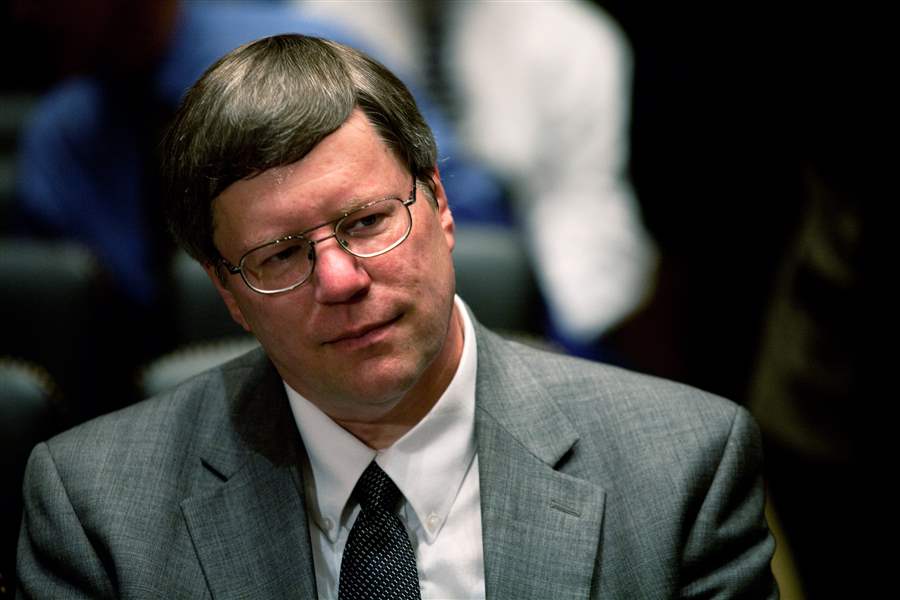
NRC lists 2 Davis-Besse issues
Neither seen as imminent threat, but plant safety 'degraded'
7/28/2011
David Lochbaum, nuclear safety engineer for the Cambridge,Mass.-based Union of Concerned Scientists.
GETTY IMAGES

David Lochbaum, nuclear safety engineer for the Cambridge,Mass.-based Union of Concerned Scientists.
OAK HARBOR, Ohio -- Two Davis-Besse direct-current electrical systems were in "an unanalyzed condition that significantly degrades plant safety" for years, according to an event report posted Wednesday on the Nuclear Regulatory Commission's Web site.
While the government regulator acknowledged the two issues existed long before Japan's Fukushima crisis, it did not see either as an imminent threat. It allowed FirstEnergy Corp. to continue operating the Ottawa County nuclear plant at full power.
In its report, FirstEnergy recognized that backup lift oil pump motors were not "environmentally qualified" with an emergency lighting panel inside the nuclear containment area.
"This could challenge the adequacy of electrical separation between the potentially grounded nonsafety related equipment and the safety related batteries [in the event of an accident]," the utility stated.
FirstEnergy's report to the NRC also said that a ground fault in automatic transfer switches "could be transferred from one power source to the redundant source, potentially impacting the ability of both safety-related DC power sources to perform their required functions." The plant's license forbids that scenario, the report said.
Jennifer Young, FirstEnergy spokesman, said the issues were recently corrected. She also said the utility has extensive backup systems in place.
David Lochbaum, nuclear safety engineer for the Cambridge, Mass.-based Union of Concerned Scientists and a former NRC trainer, said Davis-Besse's wiring is among many electrical issues gaining prominence at America's 104 nuclear plants in the aftermath of the Fukushima disaster, which began with a March 11 tsunami and was exacerbated by myriad electrical problems that rendered safety systems inoperable at multiple plants in Japan.
"Somehow, accidents make people smarter," Mr. Lochbaum said, explaining how Davis-Besse's wiring irregularities likely have existed for decades.
Both FirstEnergy and the NRC said they are part of the plant's design basis. Davis-Besse went online in 1977.
Mr. Lochbaum said he finds it amazing that the first post-Fukushima look at Davis-Besse's wiring configuration "magically vaporized all the clouds or curtains or whatever had been hiding this safety violation for all those decades."
He said that if the nonqualified electrical component had shorted out, an electrical fault could have disabled all of the safety equipment sharing that panel.
"So workers opened a breaker, effectively removing the offending equipment from the supposedly protected panel," Mr. Lochbaum said. "Now, workers and NRC inspectors look at AC and DC power problems in a new light. That new perspective is flushing out old problems."
Scott Burnell, spokesman for the NRC's headquarters in Rockville, Md., said Mr. Lochbaum is making too much of the post-Fukushima inspections.
The NRC has had a special task force examining lessons learned from the Japan disaster. It issued a 12-point set of recommendations on July 13, agreeing that America's nuclear plants need to become safer.
The agency's own task force called upon the NRC to replace a "patchwork of regulatory requirements" developed over decades with a more "logical, systematic, and coherent regulatory framework."
A recent follow-up inspection at Davis-Besse showed that a potential short in nonsafety related AC systems inside containment could serve as a pathway to safety-related DC sources, Mr. Burnell said.
He said the agency now wants DC systems separate from AC systems.
"It's the DC power that's the issue, not the two nonsafety systems noted in the report," Mr. Burnell said. "Properly getting DC power to safety-related instrumentation and systems is certainly important. Power was rerouted to the nonsafety systems to eliminate the potential pathway, so safe operation continues. The overall condition, which had the potential to affect plant safety (and was therefore categorized as such), will be analyzed further."
Mr. Burnell acknowledged, though, that Fukushima has reaffirmed the need for plants to deal with station blackouts.
But he said the situation described in FirstEnergy's event report "would have received the same attention if the [Fukushima] accident never happened."
Contact Tom Henry at: thenry@theblade.com or 419-724-6079.